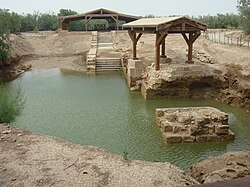Baptism of Christ

Al-Maghtas ruins on the Jordanian side of the Jordan River are the location for the Baptism of Jesus and the ministry of John the Baptist.
|
|
| UNESCO World Heritage Site | |
|---|---|
| Location | Balqa Governorate, Jordan |
| Criteria | iii, vi |
| Reference | 1446 |
| Inscription | 2015 (39th Session) |
|
[]
|
|
The baptism of Jesus marks the beginning of his public ministry. This event is described in the gospels of Matthew, Mark and Luke. John's gospel does not directly describe Jesus' baptism.
Most modern theologians view the baptism of Jesus by John the Baptist as a historical event to which a high degree of certainty can be assigned. Along with the crucifixion of Jesus, most biblical scholars view it as one of the two historically certain facts about him, and often use it as the starting point for the study of the historical Jesus.
The baptism is one of the five major milestones in the gospel narrative of the life of Jesus, the others being the Transfiguration, Crucifixion, Resurrection, and Ascension. Most Christian denominations view the baptism of Jesus as an important event and a basis for the Christian rite of baptism (see also Acts 19:1-7). In Eastern Christianity, Jesus' baptism is commemorated on 6 January (the Julian calendar date of which corresponds to 19 January on the Gregorian calendar), the feast of Epiphany. In the Roman Catholic Church, the Anglican Communion, the Lutheran Churches and some other Western denominations, it is recalled on a day within the following week, the feast of the baptism of the Lord. In Roman Catholicism, the baptism of Jesus is one of the Luminous Mysteries sometimes added to the Rosary. It is a Trinitarian feast in the Eastern Orthodox Churches.
...
Wikipedia
